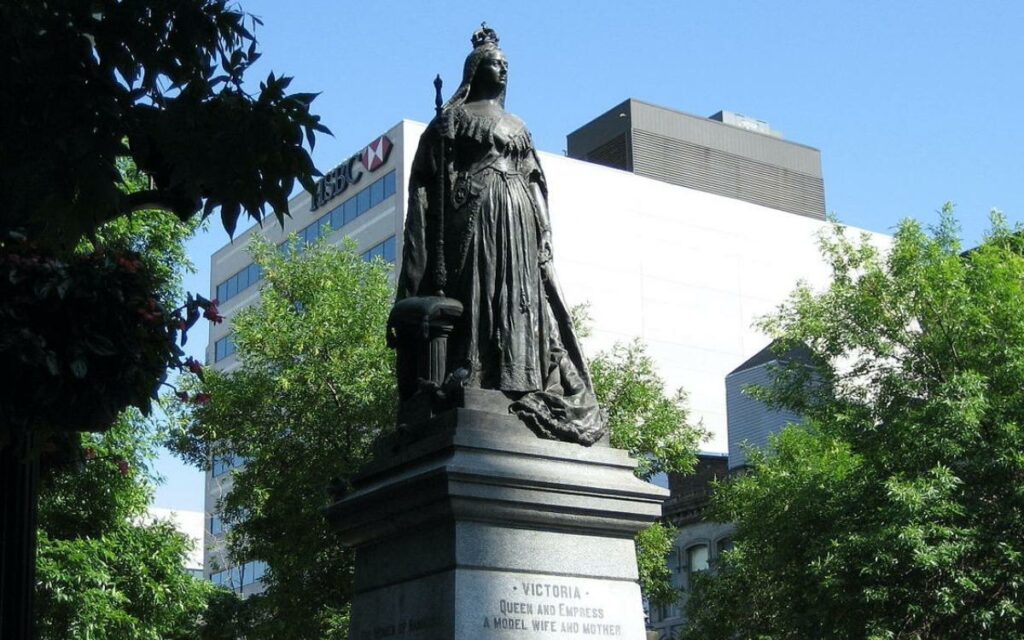
The Queen Victoria statue in Gore Park is one of five locations deemed “potentially problematic” by the city. Photo credit: Wikimedia Commons/Rick Cordeiro
The City of Hamilton has installed new warning signs at the sites of five different monuments, stating that the city recognizes the sites as “potentially problematic.”
The five locations are the Queen Victoria statue in Gore Park, the Sir John A. Macdonald monument site in Gore Park (the statue is currently in storage after being torn down by protestors, but the pedestal remains), the Augustus Jones statue at the fountain in Downtown Stoney Creek, the United Empire Loyalists monument at the Provincial Offences Courthouse at 50 Main Street East, and the United Empire Loyalists monument at Dundurn Park.
The city says that the new signage “is meant to let the community know that we have identified these sites as potentially problematic for Indigenous people and that we are working on gathering the true history behind them.”
The signs were reportedly developed in consultation with various members of the Indigenous community.
They feature three columns of text, repeating the same message in English, Mohawk, and Anishinaabe. French text is not included on the signs.
The signs also include a QR code which can be scanned by mobile devices. The QR code directs to an audio recording of the message for the visually impaired.
The signs at each site are identical and read: “The City of Hamilton is working together with the community to provide a broader and more inclusive view of the past which may challenge some to rethink what they held to be truths. There is more than one story here. Each of the stories associated with this monument must and will be told.”
The cost of the signs was reportedly $17,000 and they are said to be temporary as the city works to decide what text will appear on each site’s permanent sign.
Sir John A. Macdonald was Canada’s first prime minister and is considered controversial since he was a key architect of Canada’s residential school system which saw Indigenous children taken from their homes to be assimilated into European culture.
However, it remains somewhat unclear why the other four monuments are considered “problematic.”
Augustus Jones, for instance, married two Indigenous women and had at least ten Indigenous children. He was a Loyalist land surveyor in the Hamilton area.
The City of Hamilton commissioned a review of monuments in July 2021 after the discovery of alleged unmarked graves at the site of a former residential school in Kamloops, British Columbia in May 2021.
The city commissioned a report by an Ottawa consulting firm called “First Peoples Group.” The report prepared for the city and presented to council was entitled “Honouring Our Roots.”
The report called for new signage at the five aforementioned Hamilton monument sites, said that the Sir John A. Macdonald statue should not be put back up, and stated that the pedestal and cannons that remain at the former Sir John A. Macdonald statue site should all be removed.
After the report, the previous Hamilton City Council voted in 2022 to place new temporary signs (and eventually permanent signs) at each of the five identified “problematic” sites.
Those temporary signs are just being put up now after a lengthy consultation process.
These latest developments follow the tearing down of Hamilton’s Sir John A. Macdonald statue by protestors in August 2021.
In July 2021, Councillors voted 12-3 to keep Hamilton’s statue of Sir John A. Macdonald standing in Gore Park after a motion from Ward 3 Councillor Nrinder Nann suggested it should be moved to storage.
An “Indigenous Unity Rally” was then planned a few weeks later in August 2021 to protest Council’s decision to keep the statue standing.
The rally began at Hamilton City Hall but then moved to the Sir John A. Macdonald statue in Gore Park.
At that point, a protestor scaled a traffic pole to spray paint a surveillance camera, another protestor scaled the statue to tie ropes around it, a smoke screen was released by someone in the crowd, and a group of people pulled the statue down.
A hammer and grinder were then used to damage Sir John A. Macdonald’s face and spray paint was used to further vandalize Macdonald’s likeness. Damage was estimated at more than $5,000.
The statue had stood in Hamilton for 128 years after being shipped from England in October 1893. It now remains in storage.
Miguel Avila-Velarde was initially charged in the toppling of the statue, but the charge was later dropped.
Avila-Velarde was identified in news stories as being of Indigenous heritage, albeit part of Peru’s Indigenous population.
He was also identified as being a resident of Toronto.

Based in Hamilton, he reaches hundreds of thousands of people monthly on Facebook, Instagram, TikTok, and Twitter. He has been published in The Hamilton Spectator, Stoney Creek News, and Bay Observer. He has also been a segment host with Cable 14 Hamilton. In 2017, he received the Chancellor Full Tuition Scholarship from the University of Ottawa (BA, 2022). He has also received the Governor General’s Academic Medal. He formerly worked in a non-partisan role on Parliament Hill in Ottawa.






